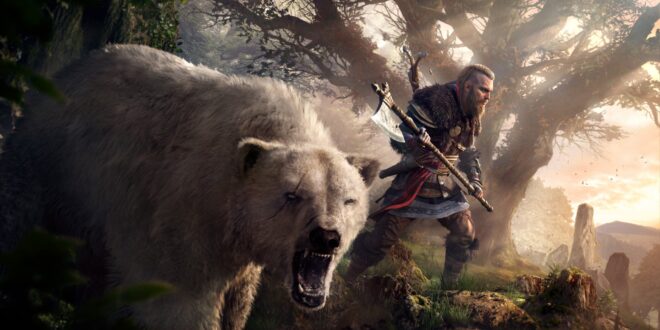The Assassin’s Creed franchise has in recent years garnered significant praise for its accessibility options. In an industry where these options are still sadly far from the norm, Ubisoft to its credit has gone to some lengths to ensure the series remains accessible to as many players as possible.
It was hardly a surprise, then (though no less welcome) when the reveal for the upcoming Assassin’s Creed Valhalla was accompanied by an audio description (AD) trailer.
The trailer was put together by Descriptive Video Works, working in collaboration with Ubisoft. The company works to make all kinds of videos accessible and enjoyable to people who are blind and low-vision by adding audio descriptions.
We sat down with Diane Johnson, head of studio at Descriptive Video Works to find out more about the work that goes into making Ubisoft’s vikings more accessible.
What are the challenges behind adding audio description to a trailer like Assassin’s Creed: Valhalla? Is it a balance to provide accurate descriptions for visually impaired players, while still maintaining the intended atmosphere of the trailer?

The biggest challenge with trailers, especially a visually rich one like Assassin’s Creed Valhalla, is fitting accurate descriptions into the small gaps between voiceovers, dialogue, and important sound effects. It is an exercise in careful word choice to bring maximum impact with minimum syllables. We have to carefully choose what to describe and how to describe it.
There is also a challenge to sounding like our descriptions are a natural part of the trailer so they are part of a seamless audio experience for someone who is blind. We want to make sure they know which voice is the audio description, so it can’t sound just like anyone else in the video, but it also must sound like it is a part of the video and doesn’t stand out in the wrong way. We have a diverse team of professional narrators that we work with, so we can choose the right voice type and accent for any project. They have been trained in the subtle readings required for AD and can bring the right tone to any genre. It is also why we use all real human voices – no synthetic voices yet – because there is a bit of emotion required in the voice for it to really fit the atmosphere.
What other challenges are there in audio descriptions – such as keeping descriptions succinct while remaining age-appropriate?
Audio description is a complex art. Our writers go through a special in-house training to prepare them. Some of the challenges they face include describing difficult scenes such as violence or sex without censorship and choosing the perfect word for both the time available and the intended audience of the video.
What was your reaction to the response to the audio description trailer for Valhalla?
We were blown away! With most projects, we send the client the AD track and don’t hear anything after. It gets broadcast on TV or goes up on a streaming service, and we never really know how many people listened to it or what they thought of it.
Every once in a while, we get someone who will email us or post about the AD on a project we worked on social media, which is so lovely. I think the biggest response recently was when Netflix released AD for all seasons of Breaking Bad. We were thrilled to have done this back catalogue project for them, and we received several kind compliments and expressions of gratitude for that one – maybe 12 people reached out to us.
In contrast, the described trailer for Valhalla was posted on YouTube, where there’s a count of how many people have viewed it and an active comment section. Right now, it is at over 62,000 views for the described version alone, and so many comments! We have loved the compliments, especially the people who want our narrator to describe the whole game to them. And we’ve been bemused by the people who obviously stumbled upon it without knowing what audio description is or who it serves. There was a lot of education going on in the comments where people were explaining to each other that blind people do indeed use the internet, watch YouTube videos, and play video games.
How did the collaboration with Ubisoft come about? What level of input does the publisher have over the audio described trailer?
 Ubisoft approached us, wanting to take a next step in accessibility. They already work really hard on accessibility issues, and getting trailers audio described is an easy way to include another audience in the fun and excitement of their releases. One of the many cool things about the Valhalla AD trailer was that it was released at the same time as the non-described trailer. It wasn’t an after-thought; people who are blind and low-vision were able to experience the trailer at the same time as everyone else.
Ubisoft approached us, wanting to take a next step in accessibility. They already work really hard on accessibility issues, and getting trailers audio described is an easy way to include another audience in the fun and excitement of their releases. One of the many cool things about the Valhalla AD trailer was that it was released at the same time as the non-described trailer. It wasn’t an after-thought; people who are blind and low-vision were able to experience the trailer at the same time as everyone else.
Ubisoft was very hands-on with the AD process. First, we had a conversation about what needed to be written into the AD so we’d be including the details and Easter Eggs that people would be talking about, so the AD audience would be equally able to participate in those conversations. Then we sent them several demos of possible narrators for them to choose from. Next, we sent them a copy of the AD script before recording it for their approval. It was very much a collaboration.
We do have clients who prefer to be more hands-off and we can accommodate that as well. We’ve been doing audio description for 17 years, so producers know that they can just send us the video and know that it will be done correctly.
Why do you feel it is important to have authentic and diverse casting of narrators, especially within the LGBT community?
We have been able to work on a very diverse body of work, which has led us to grow a very diverse team of narrators. When we choose a narrator for a project, especially one that has themes around race or LGBT issues, we want to respect both the needs and intentions of the project and we want to offer the audience the very best listening experience. We secure a narrator who sounds like they could be part of the story that’s being told.
What more can video games do to promote further accessibility?
We may be a bit biased, but we feel that audio description is the next step in video game accessibility, and it is just a matter of which company is going to do it first. The recent release of The Last of Us Part 2 set a new high standard with all its amazing accessibility features, and we see audio description of cut scenes and animation as the next barrier for gaming studios to tackle. The coming of new gaming consoles that will have more memory available for audio means it will be easier to have that extra audio track for the descriptions, and that takes care of the technological challenge, so now it’s just which game will be the first to take advantage of the possibility.
What audio description will do for gamers who are blind and low-vision is let them become more immersed in the world of the game, to better understand the environment they are interacting with and enjoy the story of the game more. It is all about making sure everyone can enjoy the entertainment they love equally.

 MCV/DEVELOP News, events, research and jobs from the games industry
MCV/DEVELOP News, events, research and jobs from the games industry




